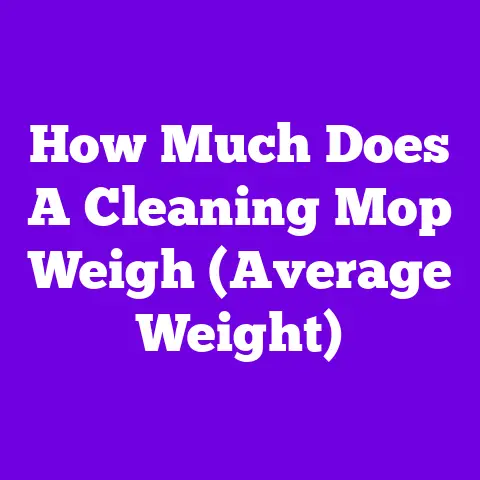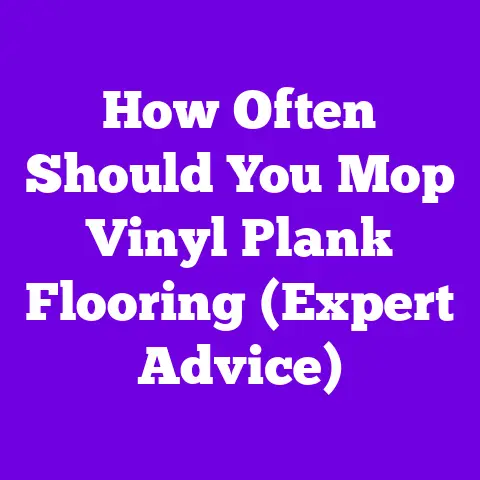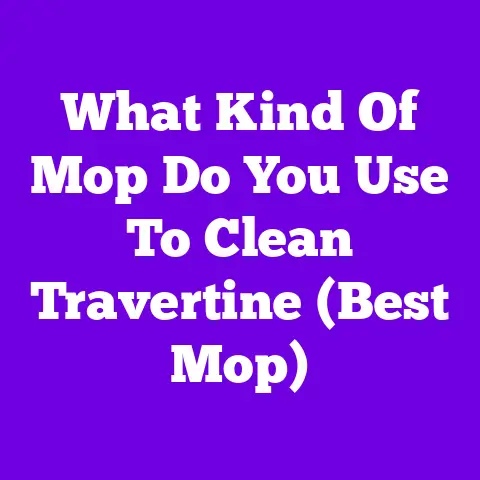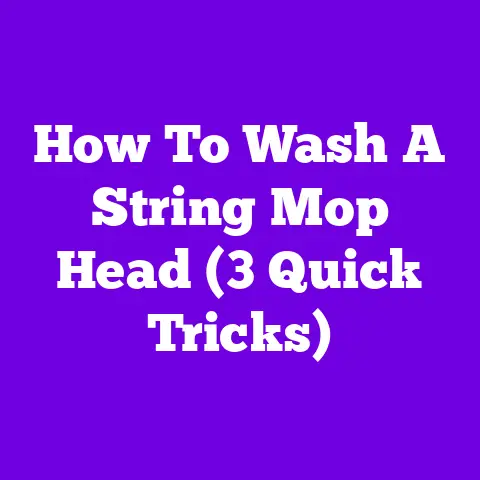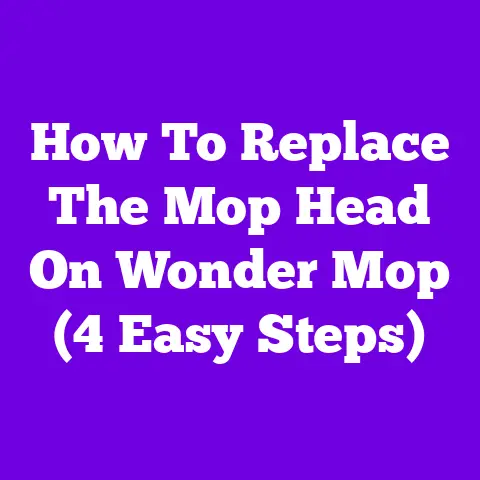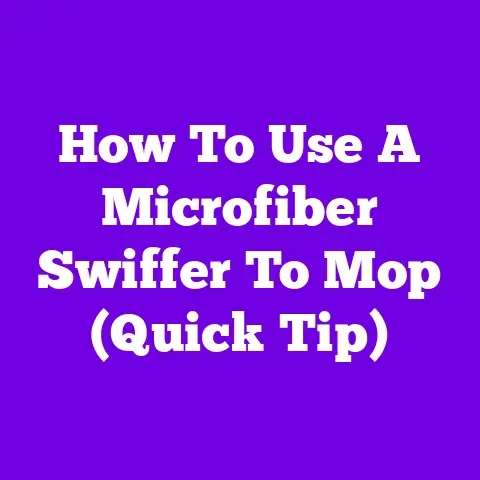Is A Dust Mop Good For Wood Floors (Best Choice?)
I remember the time I first moved into my new home with beautiful hardwood floors. Naively, I grabbed a regular broom, thinking it was the best way to keep them clean. Big mistake! The scratches and dullness that followed taught me a valuable lesson. So, is a dust mop really the best choice for wood floors? Let’s unpack this together.
Is A Dust Mop Your Best Friend for Wood Floors?
When a Dust Mop Comes to the Rescue
Have you ever looked at your wood floor and thought, “Where does all this dust come from?” It seems to appear out of nowhere, right? Dust mops can be lifesavers in this situation, but choosing the right one is crucial.
Why Choose a Dust Mop?
Dust mops offer several advantages:
- Gentle on Wood: Unlike brooms that can scratch, dust mops have soft fibers designed to treat your wood with care. They glide smoothly over the surface, picking up dust without causing damage.
- Efficient Cleaning: With their wide reach, dust mops can cover large areas quickly, making them ideal for those times when you’re in a hurry but still want a thorough clean.
- Reusable: Many dust mops come with washable heads. This not only saves you money but also makes them an eco-friendly option. I love knowing I’m doing my part for the planet!
- Versatility: Dust mops aren’t just for floors. They can be used to clean walls, ceilings, and even high shelves. It’s like having a multi-tool for cleaning.
- Hypoallergenic: For those with allergies, dust mops can help reduce allergens in your home by trapping dust and pollen effectively.
Types of Dust Mops
Choosing the right type of dust mop is essential for getting the best results. Here’s what you should know:
- Microfiber Mops: These are my personal favorite because they trap dust with an almost magnetic attraction and are incredibly soft on wood floors, reducing the risk of scratches.
- Cotton Mops: While good for light dusting, they might leave lint behind, which can be frustrating.
- Electrostatic Mops: These use static electricity to grab dust particles. They’re highly effective but can be more expensive than other options.
- Disposable Dust Mops: Convenient for quick cleaning sessions, these are great when you don’t have time to wash mop heads. However, they’re less eco-friendly due to single-use pads.
Prepping to Mop
Before you start mopping, make sure you have everything you need:
- Dust Mop: Choose one that suits your floor type (microfiber is generally the safest bet).
- Mop Handle: Ensure it’s adjustable to fit your height comfortably.
- Dustpan and Brush: For collecting any larger debris after mopping.
- Protective Gear: If you’re sensitive to dust, consider wearing a mask and gloves.
How I Dust Mop My Wood Floors
Over the years, I’ve developed a method that works wonders for my floors. Here’s how I do it:
- Clear the Area: Start by moving any furniture or obstacles out of the way. This ensures you can reach every corner of the room.
- Attach the Mop Head: Make sure it’s secured properly. There’s nothing worse than having it fall off in the middle of cleaning!
- Start Mopping:
- Begin at one corner of the room and work your way across.
- Use long, even strokes to cover more ground and overlap each pass slightly to avoid missing any spots.
- Pay special attention to areas under furniture where dust tends to accumulate.
- Shake and Clean:
- After every few strokes, take the mop outside and shake it gently to release trapped dust.
- Continue mopping until the entire floor is clean and dust-free.
- Finish Up:
- Use a dustpan to collect larger debris.
- Wash the mop head according to its instructions if it’s reusable.
Common Mistakes to Avoid
It’s easy to make mistakes when cleaning wood floors, but here are some tips to help you avoid them:
- Rushing: Take your time to ensure no spots are missed. A rushed job often leaves behind dust patches.
- Using a Dirty Mop: Always start with a clean mop head. A dirty mop just spreads more dirt around.
- Skipping Corners and Edges: Dust loves to hide in these areas, so give them extra attention.
- Using Too Much Pressure: Light pressure is all you need. Pressing too hard can cause scratches or damage.
Post-Mopping Care
Once you’ve finished mopping, here’s what you should do:
- Wash the mop head according to the manufacturer’s instructions.
- Store the mop in a dry place to prevent mildew or bacterial growth.
- Take a moment to admire your sparkling clean floor!
Safety First
While dust mopping is generally safe, consider these precautions:
- Avoid wetting the mop excessively; too much water can damage wood floors.
- Watch out for slippery spots that might cause accidents.
- If you’re sensitive to dust, wear protective gear like masks or gloves.
Advanced Techniques for Cleaning Wood Floors
Let’s dig deeper into some advanced techniques and lesser-known tips for maintaining wood floors:
Using Natural Cleaning Solutions
Many people prefer natural cleaning solutions for their homes. Here’s how you can incorporate them into your routine:
- Vinegar Solution: Mix one part vinegar with two parts water for a simple yet effective cleaner. It’s great for cutting through grime without harming your floors.
- Essential Oils: Add a few drops of essential oils like lemon or lavender to your cleaning solution for a pleasant scent and added antibacterial properties.
- Baking Soda Paste: For stubborn spots, make a paste with baking soda and water. Apply gently with a soft cloth and wipe clean.
Polishing Your Wood Floors
Polishing adds an extra layer of protection and shine to your floors:
- Choose a polish specifically designed for wood floors.
- Apply it evenly using a clean cloth or applicator pad.
- Allow it to dry completely before walking on the floor.
Deep Cleaning Tips
For those times when your floor needs more than just dusting:
- Vacuum regularly to pick up hair before mopping.
- Consider using pet-safe cleaning products.
- Keep pet nails trimmed to prevent scratches on the floor.
Handling High-Traffic Areas
High-traffic areas like hallways and entryways require more frequent attention:
- Place mats or rugs at entrances to catch dirt before it hits the floor.
- Clean these areas more often than less-used spaces.
Dealing with Spills and Stains
Accidents happen! Here’s how to handle them:
- Blot spills immediately using a soft cloth.
- Avoid rubbing as it can spread stains further.
- For stubborn stains, use appropriate cleaners recommended by flooring experts.
Prolonging Your Floor’s Lifespan
Here are some long-term strategies for keeping your wood floors in top condition:
- Use furniture pads under chairs and tables to prevent dents.
- Maintain consistent humidity levels in your home to avoid warping.
- Refinish floors as needed every few years to restore their original luster.
FAQ Section
1. Can I use any kind of dust mop on my wood floors?
While most dust mops are safe, microfiber is typically recommended due to its gentle nature on wood surfaces.
2. How frequently should I dust mop my floors?
If your home sees a lot of traffic or has pets, daily mopping may be necessary. Otherwise, 2-3 times a week should suffice.
3. Are there specific products I should avoid using on wood floors?
Yes, steer clear of harsh chemicals like bleach or ammonia as they can damage the finish of your wood floors.
4. What if my floor has deep scratches or damage?
In such cases, professional refinishing might be required to restore the floor’s appearance.
5. Is it necessary to polish wood floors regularly?
Polishing isn’t required after every cleaning but doing so every few months can help maintain shine and protect against wear.

